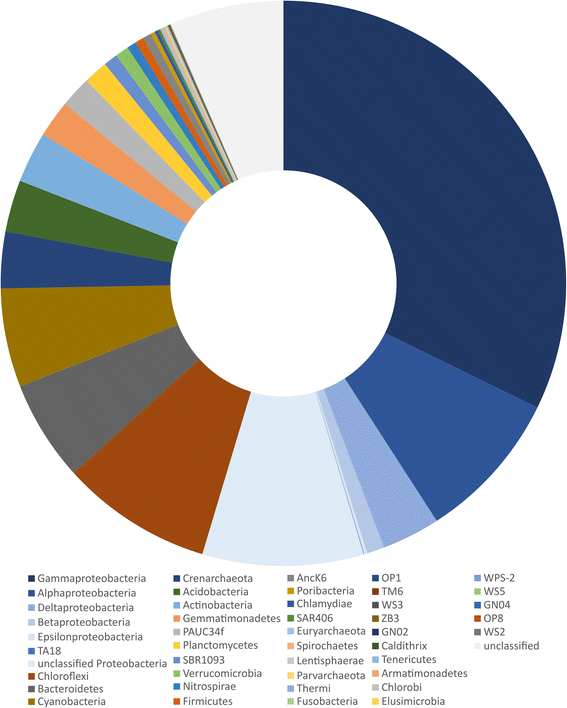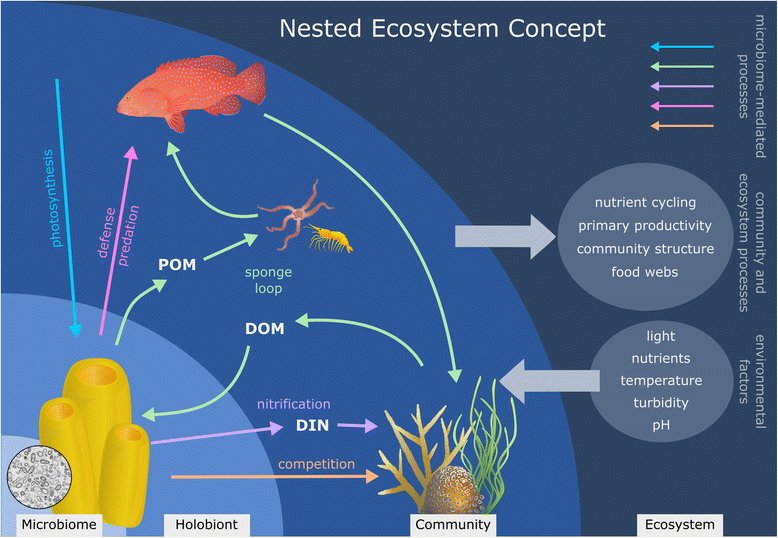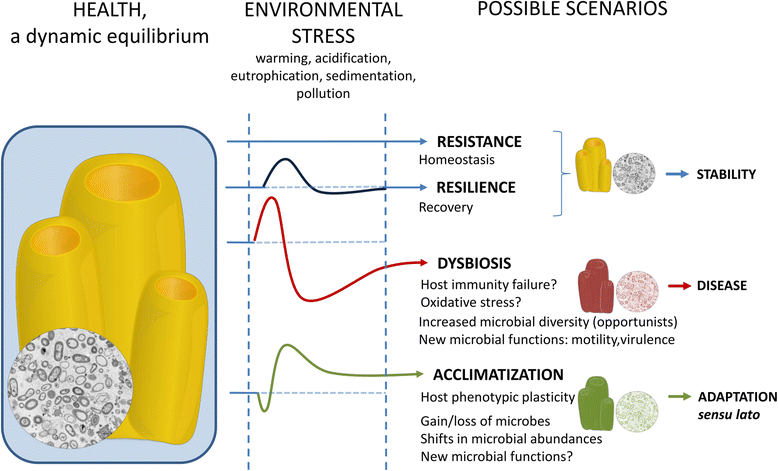The sponge holobiont in a changing ocean: from microbes to ecosystems
- PMID: 29523192
- PMCID: PMC5845141
- DOI: 10.1186/s40168-018-0428-1
The sponge holobiont in a changing ocean: from microbes to ecosystems
Abstract
The recognition that all macroorganisms live in symbiotic association with microbial communities has opened up a new field in biology. Animals, plants, and algae are now considered holobionts, complex ecosystems consisting of the host, the microbiota, and the interactions among them. Accordingly, ecological concepts can be applied to understand the host-derived and microbial processes that govern the dynamics of the interactive networks within the holobiont. In marine systems, holobionts are further integrated into larger and more complex communities and ecosystems, a concept referred to as "nested ecosystems." In this review, we discuss the concept of holobionts as dynamic ecosystems that interact at multiple scales and respond to environmental change. We focus on the symbiosis of sponges with their microbial communities-a symbiosis that has resulted in one of the most diverse and complex holobionts in the marine environment. In recent years, the field of sponge microbiology has remarkably advanced in terms of curated databases, standardized protocols, and information on the functions of the microbiota. Like a Russian doll, these microbial processes are translated into sponge holobiont functions that impact the surrounding ecosystem. For example, the sponge-associated microbial metabolisms, fueled by the high filtering capacity of the sponge host, substantially affect the biogeochemical cycling of key nutrients like carbon, nitrogen, and phosphorous. Since sponge holobionts are increasingly threatened by anthropogenic stressors that jeopardize the stability of the holobiont ecosystem, we discuss the link between environmental perturbations, dysbiosis, and sponge diseases. Experimental studies suggest that the microbial community composition is tightly linked to holobiont health, but whether dysbiosis is a cause or a consequence of holobiont collapse remains unresolved. Moreover, the potential role of the microbiome in mediating the capacity for holobionts to acclimate and adapt to environmental change is unknown. Future studies should aim to identify the mechanisms underlying holobiont dynamics at multiple scales, from the microbiome to the ecosystem, and develop management strategies to preserve the key functions provided by the sponge holobiont in our present and future oceans.
Keywords: Climate change; Disease; Dysbiosis; Health; Holobiont; Microbiome; Nested ecosystems; Sponges; Stress; Symbiosis.
Conflict of interest statement
Ethics approval and consent to participate
Not applicable.
Consent for publication
Not applicable.
Competing interests
The authors declare that they have no competing interests.
Publisher’s Note
Springer Nature remains neutral with regard to jurisdictional claims in published maps and institutional affiliations.
Figures



Similar articles
-
Metagenomic Analysis of Genes Encoding Nutrient Cycling Pathways in the Microbiota of Deep-Sea and Shallow-Water Sponges.Mar Biotechnol (NY). 2016 Dec;18(6):659-671. doi: 10.1007/s10126-016-9725-5. Epub 2016 Nov 7. Mar Biotechnol (NY). 2016. PMID: 27819120
-
Subcellular view of host-microbiome nutrient exchange in sponges: insights into the ecological success of an early metazoan-microbe symbiosis.Microbiome. 2021 Feb 14;9(1):44. doi: 10.1186/s40168-020-00984-w. Microbiome. 2021. PMID: 33583434 Free PMC article.
-
Marine microbial symbiosis heats up: the phylogenetic and functional response of a sponge holobiont to thermal stress.ISME J. 2013 May;7(5):991-1002. doi: 10.1038/ismej.2012.165. Epub 2013 Jan 3. ISME J. 2013. PMID: 23283017 Free PMC article.
-
The Microbial Ecology of Antarctic Sponges.Microb Ecol. 2025 May 17;88(1):44. doi: 10.1007/s00248-025-02543-y. Microb Ecol. 2025. PMID: 40382475 Free PMC article. Review.
-
The Macroalgal Holobiont in a Changing Sea.Trends Microbiol. 2019 Jul;27(7):635-650. doi: 10.1016/j.tim.2019.03.002. Epub 2019 May 2. Trends Microbiol. 2019. PMID: 31056303 Review.
Cited by
-
Bacteria Associated with Benthic Invertebrates from Extreme Marine Environments: Promising but Underexplored Sources of Biotechnologically Relevant Molecules.Mar Drugs. 2022 Sep 29;20(10):617. doi: 10.3390/md20100617. Mar Drugs. 2022. PMID: 36286440 Free PMC article. Review.
-
Characteristic Microbiomes Correlate with Polyphosphate Accumulation of Marine Sponges in South China Sea Areas.Microorganisms. 2019 Dec 30;8(1):63. doi: 10.3390/microorganisms8010063. Microorganisms. 2019. PMID: 31905988 Free PMC article.
-
Metagenomic Assessment of DNA Viral Diversity in Freshwater Sponges, Baikalospongia bacillifera.Microorganisms. 2022 Feb 21;10(2):480. doi: 10.3390/microorganisms10020480. Microorganisms. 2022. PMID: 35208935 Free PMC article.
-
Nested interactions between chemosynthetic lucinid bivalves and seagrass promote ecosystem functioning in contaminated sediments.Front Plant Sci. 2022 Jul 22;13:918675. doi: 10.3389/fpls.2022.918675. eCollection 2022. Front Plant Sci. 2022. PMID: 35937361 Free PMC article.
-
Variability in Host Specificity and Functional Potential of Antarctic Sponge-Associated Bacterial Communities.Front Microbiol. 2022 Jan 13;12:771589. doi: 10.3389/fmicb.2021.771589. eCollection 2021. Front Microbiol. 2022. PMID: 35095792 Free PMC article.
References
-
- Apprill A. Marine animal microbiomes: toward understanding host–microbiome interactions in a changing ocean. Front Mar Sci. 2017;4:222.
Publication types
MeSH terms
Substances
Grants and funding
LinkOut - more resources
Full Text Sources
Other Literature Sources

